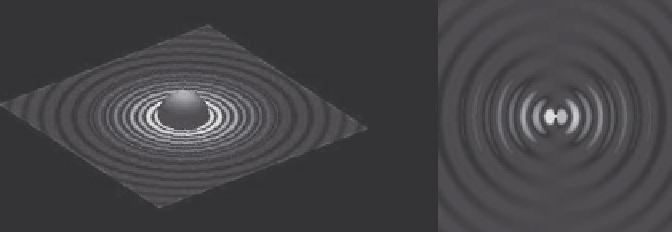Environmental Engineering Reference
In-Depth Information
For example, in the case of spherical excitation or a monopole noise source the
sound is radiated in all directions and the sound level is reduced by 6 dB for each
doubling of distance from the source.
A moving train is a
line source
, and it emits equal sound power output per unit
length of the train line. A line source produces cylindrical spreading, resulting in a
sound level reduction of 3 dB per doubling of distance. The spherical propagation
is associated with the three-dimensional propagation and the line source with the
one-dimensional sound wave propagation, respectively. When two monopole
sources of equal strength but opposite phase are put together at a short distance
they produce a dipole, which is referred as two-dimensional sound wave propagation.
Figure 9 shows the sound directivities of a monopole and a dipole.
4.2 Air absorption
Air absorption of sound is driven by two mechanisms: molecular relaxation
and air viscosity. Molecular relaxation is the transition of a molecule from an
excited energy level to another excited level of lower energy. High frequencies
are absorbed more than low because they have short wave length and therefore
the waves dissipate as they travel through the air molecules. The air absorption
must be taken into account at high frequencies when calculating the reverberation
time of a room. It is due to friction between air particles as the sound wave travels
through the air. The amount of absorption depends on the temperature and humidity
of the atmosphere [ 10 ].
4.3 Ground absorption
The ground can contribute to the sound attenuation by two mechanisms sound
absorption and sound refl ection. When the sound hits the ground the acoustic
energy loss depends on the refl ection coeffi cient of the surface. On hard surfaces
attenuation occurs due to the acoustic energy losses on refl ection while on porous
surfaces, sound levels are being reduced due to the increased absorption of the
ground. High frequencies are generally attenuated more than low frequencies.
The refl ection coeffi cient depends on the impedance of the two media, in this
case, air and ground, and represents the absorbency of the ground in a homogeneous
(a)
(b)
Figure 9: (a) Monopole; (b) dipole.

Search WWH ::

Custom Search